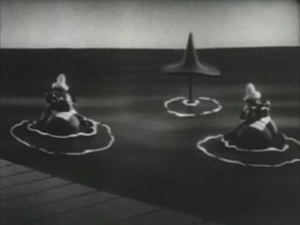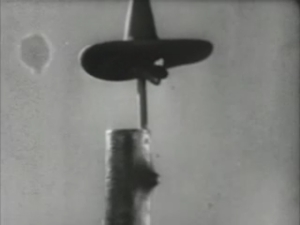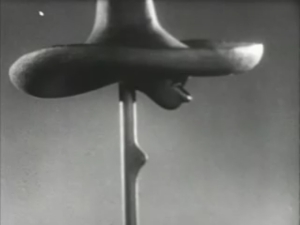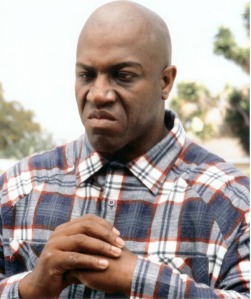Blog Archives
The Lady Said No
Several years ago – a veritable eternity in Internet Time – Jerry Beck and Amid Amidi, the animation historians/enthusiasts who run the venerable and essential site Cartoon Brew, launched a subsite, Cartoon Brew Films, which they used as a venue for hosting and distributing, for a small fee, a number of cartoons that had slipped through the cracks of film history. The very first film featured on Cartoon Brew Films was Frank Tashlin’s unusual 1946 stop-motion film The Lady Said No, which had fallen into the public domain.
At the time, I was researching my dissertation on Tashlin, so I eagerly downloaded the film, and felt obliged to submit a lengthy-ish comment to Cartoon Brew Films. Alas, Cartoon Brew Films has gone the way of the dodo, taking with it my comments.
The comments, I assure you, were no great loss, but I have nevertheless and perhaps ill-advisedly used them as the basis for my notes below on The Lady Said No, which you can watch below, via YouTube. It is not the highest-quality version of this film, but, then, we’re fortunate that it survives at all. I cannot account for the flickering between color and black and white.
The Lady Said No was made using a labor-intensive stop-motion process called “replacement animation,” whereby, for instance, animators would craft, for a single character, multiple heads, each with a different facial expression or lip-position. The heads would fit into the character’s body using some variation of a ball-and-socket joint, and would be swapped out as often as necessary, frame-by-frame, to convey changes in facial expression and/or lip movement. As indicated in the link just above, replacement animation is most strongly associated with George Pal, best known for his “Puppetoon” films, but most beloved by me for 7 Faces of Dr. Lao (1964), an oddball movie that gives the great Tony Randall (whom I interviewed once, not a year before he died) a chance to ham it up under layers of crazy make-up.
Modern audiences are most familiar with replacement animation from the films The Nightmare before Christmas and the works of Aardman Studios, makers of the delightful Wallace & Gromit films (notably the truly brilliant Wallace & Gromit in the Curse of the Were-Rabbit), and Chicken Run.
Here is a fascinating bit of film history: a photo essay, from a 1946 issue of Popular Science, about the process used to make this very film. I’ve scanned and uploaded the three-page spread as two (rather large) PDF files: one PDF of the two-page color spread, and one black-and-white page. Some edges got cut off and you’ll have to pardon the three-ring-binder punchholes. The article is really worth a look – the photos are great, and you get some sense of the massive amounts of work required to produce a film that has, 65 years later, been almost entirely forgotten.
The full citation information is:
Bob Newman [photgrapher], “Six-Inch Wax Dolls Are New Stars in Filmland,” Popular Science, Vol. 148, No. 5 (May 1946), pp. 108-109.
So The Lady Said No – whose main character, by the way, is meant to resemble legendary Mexican comedian Cantinflas – was made using an unusual animation process, but is also unusual for the ways in which it combines stop-motion technique with traditional 2D animation. Notice, for instance, the “motion lines” when the main character dashes away at around 1:12; the ripples that emanate from the bodies of the waterlogged singers around 4:33; and the smoke clouds at 5:44.

1:12: The setting and puppets are 3D; so far as I can tell, the streaky "motion lines" were painted onto a flat surface.
This was Tashlin’s first foray into stop-motion, which makes these creative techniques all the more impressive. One of my central claims about Tashlin is that he was unusually visually inventive, and The Lady Said No would seem to confirm that idea.
In that stop-motion animation can depict (not just represent) three-dimensionality, it is tempting to see it as “closer” to live-action filmmaking than is 2-D animation. Much of the literature on Tashlin accounts for his career within the bounds of an uncomplicated arc: his work “evolves” and becomes more sophisticated as he moves from animation to live-action. This is too simplistic; it is in fact one of the points with which, in my upcoming book on Tashlin, I take issue most strongly. Tashlin is usefully considered as a gifted visual artist. The print cartoons he did in the 1930s, for instance, are no more or less “sophisticated” than his feature films of the 1950s; they are all products of a restless, curious visual/comic intelligence.
One of the continuities between The Lady Said No and much of Tashlin’s other works is his reliance on tried-and-true comic forms, most plainly the gag/topper/topper-topper structure. Tashlin is a master of setting up gags, varying them, and amplifying them. One of the best in The Lady Said No has to do with the long-necked singer’s Adam’s apple.
The first time we see the Adam’s apple, in a close-up at 1:34, it is funny in its own right, as it slides up and down the singer’s neck.
The second time we see the Adam’s apple, at 4:37, Tashlin emphasizes the up-and-down movement by echoing it in the movement of the fish’s eyeballs.
The third time (5:59), the character sings from inside a cactus, and the cactus’s skin (hide? bark?) bulges and moves along with the Adam’s apple behind it: the gag is thus intensified.
The last time this gag appears (7:11), Tashlin treats it to a variation that ties in beautifully with the culmination of the film’s narrative. We have a new singer – one of the main character’s many, many babies – whose acrobatic Adam’s apple completes this gag cycle as it brings closure to the story: woo whom you want, but be prepared for the consequences. Tashlin makes his point about the dangers of romance (a theme common in his work) with, as is typical, a sight gag.
The camera is quite mobile in The Lady Said No, moving along all axes with great vigor. Tashlin often composes shots from unusual angles, but we should not take this as a sign of his becoming “more cinematic”: animation is film, too, and is therefore no less ontologically cinematic than any other film form.
I prefer to see the film’s several, striking moving-camera shots as fulfilling two goals. First, they are evidence of Tashlin’s interest in undermining animation’s reliance on the frontal, “proscenium”-style staging that made even some of the best Looney Tunes and Merrie Melodies somewhat “flatter” than they might otherwise have been – see, for instance, most of Friz Freleng’s (generally excellent) 1930s films. The rapid camera movement onto the “stage” at 7:25 is a particularly witty gesture, in this context.
Second, and more importantly, Tashlin moves his camera and varies his compositions whenever such a gesture will clarify or intensify his film’s comedy. The several shots of the parade of waiters are fine examples of this tendency.
 These shots are taken from “Dutch” angles, the better to render abstract the shapes of the dishes, and the better to emphasize the enormity of the meal ordered by the Lady. Another fine example: Tashlin tracks the camera to follow our hero as he is dragged behind the wagon – what better way to emphasize the humor that underpins his dilemma? Comedy was Tashlin’s great muse, and he followed it throughout his varied, fascinating career.
These shots are taken from “Dutch” angles, the better to render abstract the shapes of the dishes, and the better to emphasize the enormity of the meal ordered by the Lady. Another fine example: Tashlin tracks the camera to follow our hero as he is dragged behind the wagon – what better way to emphasize the humor that underpins his dilemma? Comedy was Tashlin’s great muse, and he followed it throughout his varied, fascinating career.
As discussed above, the basis for this essay was a long comment that I posted to the late, lamented blog Cartoon Brew Films. I would like to extend special thanks to Jerry Beck and Cartoon Brew for graciously granting permission for me to repost my comments, and to Mark Kausler, without whom The Lady Said No would likely be lost entirely.
Ice Cube: secret genius of American art cinema?
I recently wrote an essay about the development of the star persona of Ice Cube, the rapper/actor who has made the unusual transition from hardcore gangsta rapper to leading man in such “family-friendly” films as Are We There Yet? The essay, entitled “With an Attitude: The Development of Ice Cube’s Star Persona,” will soon be published in the online film journal 16:9; I’ll link to it as soon as it’s up. The thesis of the essay is that, for all the apparent and unexpected alterations to his “street” persona, Cube’s film characters are nevertheless almost always coded as gangstas – an association that he has not been able (or has not wanted) to shake.
I’ve been a fan of Cube’s music and films for some time, so it was a pleasure to revisit his albums and to see some of his films that I either had not seen, or had not seen in a long while. (I can’t say it was much of a pleasure to see Are We There Yet?, however – it’s quite a miserably made film, for which we may thank uber-hack Brian Levant.)
One of the films that was enjoyable to see again was Friday, a movie I’ve always enjoyed but had not seen in at least ten years. It’s got an easygoing, kind of loosey-goosey charm, and I find it a genuinely funny “slice of life” depiction of a kind of skewed version of South Central Los Angeles in the mid-1990s. Plus it casts as neighborhood bully Deebo none other than Tiny Lister, who is a boon to ANY film.
Friday is Cube’s fifth film, and an interesting one in his career for a couple of reasons. For one thing, it’s the first film in which he doesn’t play some sort of tough guy (though, as I argue in the 16:9 essay, he’s STILL coded as a gangsta); second, it’s the first of his films over which Cube had a significant degree of creative control. In addition to playing the lead role, Cube co-wrote and executive-produced it. It’s the moment he came into his own as a multimedia star and savvy businessman. He’s managed his career and his public image quite closely, and quite well, it seems to me.
Friday is also important because it has a very high profit-to-cost ratio. According to Box Office Mojo, Friday cost $3.5 million to produce, and returned $28,215,918 in worldwide box-office revenue (97% of which was from US theaters). $28 million does not seem like an immense figure (and if this is true for you, please consider donating to this site – I accept donations as small as $10 million!), but, again, we’re looking at the ratio of profit to cost. Using this key metric, Friday was an immensely successful film, as it made just over eight times what it cost – a very good return on investment. For comparison, look at the profit-to-cost ratio of a recent blockbuster, the nigh-unwatchable Pirates of the Caribbean: Dead Man’s Chest. This bloated film cost $225 million and racked up an incredible $1,066,179,725. In absolute terms, that’s what we call a Hell of a Lot of Money, but its profit-to-cost ratio is far smaller than that of Friday: about 4.74 to 1.
So Friday is a fascinating film for a number of reasons, but the reason that it interests me here has to do with its narrative structure. Friday eschews many of the conventions of Hollywood storytelling in ways that, curiously, align its storytelling practices with those of European art films of the 1960s and 1970s. Forgive me if some of the next section is Film Studies 101.
For nearly 100 years, Hollywood films have told their stories using roughly the same devices and techniques, for the overarching purposes of coherence and clarity: making potentially complicated stories comprehensible. For this reason, most characters in most Hollywood films are understood to have well-defined goals; stories proceed along a chain of cause and effect, in which one event bring about another, and then that event brings about another, and so forth; and most films’ stories wrap up all their loose ends by film’s end. There are several other important hallmarks of classical Hollywood narration, but these are the ones that are of interest to me here.
To illustrate classical narration, the film I almost always show in my own Introduction to Film Studies classes is Back to the Future, one of my very favorite movies, and, to me, an unsurpassed exemplar of this particular narrative form. Movies or shows about time-travel are complicated, and never really make sense (I’m looking at you, Lost); Back to the Future guides us through potentially tricky subject matter by relying heavily – and very intelligently – on the tenets of classical narration listed above: Marty’s goals are very well-defined (to make sure his future parents meet, and then to get himself back to 1985); the chain of cause and effect is very clear: Doc Brown swindles plutonium from some Libyans → the Libyans, once they track down and shoot Doc, chase after Marty, Doc’s assistant → Marty tries to flee from the Libyans by speeding away in the DeLorean time machine that Doc has made → Marty hits 88 mph, sending him back to 1955, etc.
As well, the film wraps up all loose ends: Marty’s parents are together in 1985, and happier than ever; Marty makes it back safely to his girlfriend and new truck; etc. (Back to the Future, as my students never fail to point out, does have a somewhat open ending, when Doc, Marty, and Jennifer head off to the future to address the unnamed problems with the couple’s kids: “Roads? Where we’re going, we don’t need … roads.” This is what I call the Sequel Exemption: yes, it’s a loose end, but it’s a loose end that is, really, just a dangling link in the cause-and-effect chain that’ll be picked up in the next film in the series. It’s the exception that proves the rule, and it also demonstrates our absolutely lizard-brain need to witness stories come to some sort of closure, even if we have to buy another movie ticket to see it.)
If you wanted to make a film that rejects Hollywood (on aesthetic and/or political grounds, say), then one way to do it is to reject classical Hollywood storytelling: leave your endings open, muddy your characters’ goals, loosen the chain of cause and effect. All of these techniques, and then some, are the hallmarks of so-called European Art Cinema, a loosely defined movement that peaked in the 1960s and 1970s that includes works by such stalwarts as Michelangelo Antonioni, Alain Resnais, Federico Fellini, Ingmar Bergman, and many many others. Films that exhibit these tendencies are hardly confined to Europe or to a decade or two. Films of this type have been made all over the globe, and have a long history.
When, in researching my essay on Ice Cube, I watched Friday for the first time in ten years, I was struck by how much it resembles a work of Art Cinema, a term that I’m going to stop capitalizing now. The plainest way in which Friday eschews classical Hollywood narration is its highly episodic nature. For most of the film, Craig (Ice Cube) and Smokey (Chris Tucker) sit on Craig’s porch, smoking pot and amusing themselves by watching the oddball goings-on of their neighborhood. Most of these goings-on are isolated into stand-alone segments that do not relate particularly strongly to each other, except by location and by Smokey’s and Craig’s amused responses to them.
In a representative span that lasts from about 23 minutes into the film until about 30 minutes, Craig and Smokey flirt with and ogle their attractive neighbor; then they sit on the porch, goof around, and listen to music, while Smokey tries to get Craig to smoke pot; then they rebuff an overenthusiastic and hypocritical preacher (the late, great Bernie Mac), who pulls up in a Cadillac and soon hits on the attractive neighbor; then Smokey tells a story (which we see in flashback) about the time he unknowingly smoked pot laced with angel dust and then ran around the streets in his underwear, eventually winding up in a pigeon coop; then Craig and Smokey chase a neighborhood kid who keeps knocking over garbage cans. None of these episodes has much to do with any of the others. The episodes are there for humor and to provide “atmosphere,” but they don’t really have any narrative import. The film’s story actually loosens the cause and effect linkage in a very pronounced fashion.
As well, Craig and Smokey don’t really have goals – or, if they do, their goals are loosely defined and do not really motivate the characters to do much of anything. Craig speaks repeatedly of having lost his job through a misunderstanding, but he never goes to his former employer to explain the situation, and he is no closer to having a job at the end of the movie than he was at the beginning of the movie. Smokey makes a kind of lame pledge to be more careful in his dealings with drug dealers, but this is hardly any sort of achievement, especially since Smokey has been established as a fairly irresponsible guy who doesn’t follow through on much of anything.
It’s not like there is absolutely no closure in Friday. In fact, it possesses some elements of classical narration, but they do seem a little tacked-on. Craig finally dispatches with Deebo, for instance, by laying him low in a fistfight, but there’s no guarantee that Deebo won’t continue to harass the residents of the neighborhood once he comes to. As well, Craig finally gets the attention of Debbie (Nia Long, Cube’s costar in four films, interestingly) and it seems that they will begin dating sometime shortly after the film’s story ends.
Another hallmark of classical Hollywood films is that their stories usually feature an “action” plotline and a “romance” plotline, and, moreover, that the very action that completes the one plotline generally completes the other, as well. A favorite example of mine is the first time that Trinity and Neo kiss in The Matrix. That kiss is the resolution of the action plot (it reveals that Neo is The One) as well as the resolution of the love plot (it is confirmed that Neo and Trinity love each other). In Friday, Deebo actually strikes Debbie, an event that incites Craig to get up the nerve to challenge him to a fistfight. So when Craig defeats Deebo, he beats up the Bad Guy and Gets the Girl – an ending that plays very like that of The Matrix, and many thousands of other films, as well.
Overall, though, the ending of Friday is certainly not one that closes up all loose ends. (And Debbie does not appear in either of the sequels to Friday, so apparently the romance between her and Craig was dropped. I actually haven’t seen either of those sequels, so I don’t know for sure how the films handle this matter.) But, then, in Friday, there aren’t that many loose ends to close up. Precisely because the film is so episodic, it does not have many narrative “throughlines.” While there may be questions unanswered at the end of the film, there weren’t really that many questions posed to begin with.
All of these characteristics of Friday – episodic plot, unresolved ending, goalless characters, motifs instead of narrative backbone – are indeed some of the hallmarks of art films. Canonical examples include Last Year at Marienbad (Alain Resnais, 1961), The Spider’s Stratagem (Bernardo Bertolucci, 1970 – a favorite of mine), Persona (Ingmar Bergman, 1966), L’Avventura (Michelangelo Antonioni, 1960), Weekend (Jean-Luc Godard, 1967), and many others.
Never thought that F. Gary Gray would be mentioned in the same internet breath as all those European masters of ambiguity, but there you go. (I actually like some of Gray’s films – I think Set It Off [1996] is pretty underrated.)
So, is Friday an art film?
Well, no, of course not, even if it has unexpected similarities with that broad category of film. Art films are so defined partly by their narrative tendencies, yes, but also by several other factors. They are, first and foremost, aimed at an elite, specialized audience, and they are typically made outside of mainstream commercial industries, often with funding from governments or arts agencies. Such films also play outside of multiplexes, typically in small, urban, “arthouse” cinemas like New York City’s IFC Center or Film Forum.
Friday was made by a major commercial studio, and was released in mainstream, multiplex-like cinemas so as to maximize its profit. (And, as noted above, by at least one key metric, it was an unusually profitable film.) It spawned two sequels and an animated series – things that no art film that I know of has ever done.
Maybe most importantly, the intention of Friday is not to obscure, to question, to make the audience ponder Big Questions, or to challenge us in any way. While its narrative may be episodic, it’s certainly not difficult to follow. Moreover, in most art films, film style is used to confound our expectations: cuts take us back and forth through time without warning; objects or shadows may conceal important visual information; characters behave according to incomprehensible whims; information on the soundtrack will contradict information in the image track. In art cinema, style is used to render information obtuse and unclear – precisely the opposite of the function of style in a classical Hollywood film.
Simply put, Friday does not use style in this way – not even a little bit. The film may be episodic, but it’s never unclear, obtuse, or obscure. This alone decides this question once and for all: Friday is certainly not an art film. But it certainly possesses curious and quite unexpected parallels with art cinema – factors that, I think, add to the movie’s not inconsiderable charm and easygoing comedy.
Just published: Funny Pictures
I am delighted to announce that Funny Pictures: Animation and Comedy in Studio-Era Hollywood has just been published by the University of California Press, and that, despite the inclusion of an essay of mine, it is an excellent book.
Funny Pictures, as its subtitle states, is concerned with questions of genre and animation in American film. In their introduction to the book, editors Charlie Keil and Daniel Goldmark lay out its approach to historicizing and analyzing Hollywood animation, a segment of American film that is often ghettoized and misunderstood. A question that they address that is of particular interest to me is, simply: “Why is it that, in American cinema, ‘animation’ is nearly synonymous with ‘comedy’?” After all, there’s nothing in the animated image that makes it intrinsically more humorous, somehow, than the live-action image. While it’s true that laws of physics and representation can be and usually are fractured and radically manipulated in animation, such manipulations are not necessarily tied to a generic identity.
We might look to Japan’s anime industry for contrast: animated Japanese films range across genres far more widely than do American films, particularly those made during the Studio Era. To take just a few very obvious examples: Akira is dystopian science-fiction; Grave of the Fireflies is heart-wrenching drama; the work of the late, great animator Satoshi Kon challenges the very conception of genre. But even when a work of American animation contains elements of pathos or melodrama (the incredibly moving trash-compactor scene in Toy Story 3 is a great example), it is still generally classified as a comedy; right there, at the top of the IMDB page for the film, are the three “genres” into which this film has been slotted, by general consensus: Animation, Adventure, and Comedy. (Don’t even get me started on why Animation is not a genre; that’ll be the subject for another post, perhaps. This post from the venerable Cartoon Brew sums up the issue.)
In any case, the authors of the essays in Funny Pictures investigate and historicize the complex relationship between animation and genre. I’m proud to have an essay included in this book, especially since all the other authors outclass me by several orders of magnitude. My essay, “Tish-Tash in Cartoonland” (excerpted and reëdited from my upcoming book), takes up a recurrent claim about the cinema of Frank Tashlin: that his animated films somehow “look forward to” his live-action features, and that his live-action features are somehow “cartoony.” This is one of the most persistent — and consistently ill-supported — arguments about Tashlin in the fairly scanty body of literature on his work; disputing it is in fact one of my book’s principal projects. While it’s true that Tashlin is one of the few studio-era directors (along with Gregory La Cava) to move from animation to live-action, that unusual career shift does not entirely define or explain away Tashlin’s style or films. The central claim of the essay (and of my upcoming book, The Art of Comedy: The Films of Frank Tashlin) is that considering his films in the context of genre actually explains a great deal more about them than does simply stating that Tashlin’s live-action features are “cartoony,” for instance. No one has ever satisfactorily explained what is meant by this notion.
I’ll certainly be posting more on this topic closer to the time of my book’s publication.


















